标签:des style blog http color os strong io
A method for browsing Internet of things (IoT) and an apparatus using the same are provided. In the method for browsing IoT, when a mobile device executes a browser, the browser receives information on IoT devices and displays the IoT devices on a map in the form of an icon. Accordingly, the browser displays the IoT devices on the map in the form of an icon, and provides various IoT services, so that the user can easily search for many IoT devices, connect them and receive services.
Methods and apparatuses consistent with exemplary embodiments relate to a method for browsing Internet of things (IoT) and an apparatus using the same, and more particularly, to a method for browsing IoT, which can systematically provide IoT services for various things, and an apparatus using the same.
The term "Internet of things (IoT)" appeared for the first time in the Auto-ID lab at MIT in 1998. After that, as the ITU-T announced the annual report "The Internet of Things" in 2005, it predicted that the IoT would be the most fundamental frame containing all structures of future IT industry revolution. The report defined the IoT as "a new information communication infrastructure that connects all kinds of things existing in the world through networks and enables persons and things to communicate with each other anytime and anywhere". That is, the IoT can truly be seen as an infrastructure to realize a ubiquitous space. Such a ubiquitous space starts by implanting computing devices equipped with specific functions into environments and things and making the environment and the things intelligent.
The IoT service provides a more convenient and safe life to us. Therefore, various telecommunication companies and terminal manufacturers are focusing on development of terminals and services for supporting IoT to emerge as a next generation mobile service.
However, the IoT is at an early stage and does not propose a detailed model for providing the service. Therefore, there is a need for a detailed method for providing such an IoT service.
One or more exemplary embodiments provide a browser through which a user can easily search for many IoT devices, connect them, and receive services from the IoT devices.
One or more exemplary embodiments also provide an open software platform to provide an IoT service. Through the suggested open IoT software platform, time and cost that are required to develop the IoT service can be saved and thus many developers can be easily encouraged to develop the IoT services.
The open software platform for providing such a service is divided into four platforms according to functions. The open IoT software platform includes a D-platform to connect things to the Internet to develop the open IoT software platform, a P-platform to register IoT devices and provide a search service in the global environment, and an S-platform which is an App store platform for an IoT application service environment in case that IoT application increases geometrically, and an M-platform to provide various mash-up services.
According to an aspect of an exemplary embodiment, there is provided a method for browsing Internet of things (IoT) of a mobile device, the method including: executing, by the mobile device, a browser; receiving, by the browser, information on IoT devices; and displaying, by the browser, the IoT devices on a map in a form of an icon.
The displaying may include displaying an icon of an IoT device that is accessible and an icon of an IoT device that is inaccessible in different forms.
The displaying may include displaying the icon of the IoT device that is accessible in color and displaying the icon of the IoT device that is inaccessible in black and white.
The executing may include, when an IoT browser icon is selected or a specific code is read on an initial screen by a user, executing, by the mobile device, an IoT browser.
The displaying may include, when the IoT devices are superimposed one on another on a specific area, displaying a plural IoT device icon displaying a number of corresponding IoT devices.
The method may further include, when the icon is selected, displaying, by the IoT browser, an application list screen corresponding to an IoT device corresponding to the selected icon, and the application list screen may display different buttons on corresponding application items according to whether each application is installed or not and whether each application is updated or not.
The method may further include providing a favorite list on specific locations or specific IoT devices.
According to an aspect of another exemplary embodiment, there is provided a computer readable recording medium on which software for executing the method for browsing the IoT as claimed in any one of claims?1?to?7?is recorded.
According to various exemplary embodiments, the browser displays the IoT devices on the map in the form of icons or list, and provides various IoT services, so that the user can easily search for many IoT devices, connect them and receive services.
FIG. 1?is a view illustrating a configuration of an IoT software platform?100?according to an exemplary embodiment. As shown in?FIG. 1, the IoT software platform?100?includes a D-platform?110, a P-platform?120, an M-platform?130, and an S-platform?140.
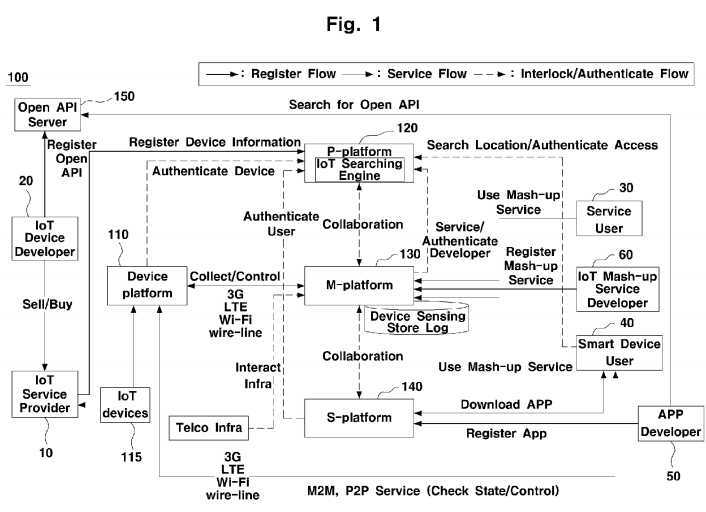
The D-platform?110?refers to a software platform that is installed at an IoT device?115?side, and the P-platform?120, the M-platform?130, and the S-platform?140?refer to software platforms that are installed at a server computer side separately or altogether.
The D-platform?110, which is an abbreviation of "Device platform", may be directly installed in the IoT device?115?or installed in an IoT adaptor mounted in the IoT device?115, and may be interlocked with the P-platform?120?and the M-platform?130and also may be interlocked with a smart device through an IoT application and an IoT website.
The IoT device?115?recited herein refers to general things to which the IoT is applied (for example, a TV, a mobile phone, a refrigerator, a washing machine, a vending machine, etc.).
The IoT adaptor is mounted in the IoT device?115?and enables the IoT device?115?to use IoT communication. The IoT adaptor includes a communication module to communicate through at least one of near field communication (NFC), Wi-Fi, Ethernet, 3rd?Generation (3G), and long term evolution (LTE), and the D-platform?110?installed in the IoT adaptor provides various functions to be able to perform IoT communication.
The P-platform?120, which is an abbreviation of "Planet platform", performs functions like managing the IoT devices?115, managing the user, monitoring the IoT devices?115, and searching for the IoT devices?115. Specifically, the P-platform?120receives information on the IoT devices?115?from an IoT service provider?10?and registers the IoT devices?115. At this time, the information on the IoT devices?115?includes a device ID, a device name, a model name, a manufacturer, location information and device state information, and includes an address which is necessary when the IoT devices are connected (for example, an IP address, MSISDN, etc.).
The P-platform?120?authenticates a user who accesses the S-platform?130?to register and download an IoT application for an IoT service. The P-platform?120?stores personal information such as ID/PW and telephone number of the user to authenticate the user.
Also, the P-platform?120?may authenticate a developer who develops and registers an IoT-related mash-up service or a service user who uses a mash-up service.
In addition, the P-platform?120?may authenticate IoT service access of an IoT service user using an application of a smart device (for example, a smartphone, a tablet, etc.).
The M-platform?130, which is an abbreviation of "Mash-up platform", communicates with the D-platform?110?and forwards a control command of the service user using the IoT application or the IoT webpage to the IoT device?115.
The M-platform?130?registers an IoT mash-up service which is developed by a mash-up service developer?60. That is, the mash-up service developer?60?develops the IoT mash-up service and registers it at the M-platform?130. At this time, the mash-up service developer?60?may develop the IoT mash-up service using an IoT open application programming interface (API) provided by an open API server?150.
The IoT devices?115?transmit data generated by them to the M-platform?130?periodically, and accordingly, the M-platform130?collects the data generated by the IoT devices?115?and stores the data as a log, such that the data is used to provide various IoT mash-up services to the service user.
Also, the M-platform?130?may charge for the use of the IoT mash-up service and may store brief information on the IoT devices?115?(for example, ID, IP address, etc.).
The S-platform?140, which is an abbreviation of "Store platform", provides an application store function of providing an IoT application for an IoT service to the service user. To achieve this, the S-platform?140?provides an application search function. The S-platform?140?may search for an IoT application with reference to the ID of the IoT device?115?for the user to use an IoT function of the IoT device?115.
To achieve this, the S-platform?140?registers an IoT application which is developed by an IoT application developer?50.
The open API server?150?manages and provides an open API related to the IoT service. Specifically, the development company of the IoT device?115?develops the open API on the IoT device?115?when manufacturing the IoT device?115, and registers and stores the relevant open API at the open API server?150. That is, the open API server?150?may register, store, and manage various open APIs on the IoT devices?115?developed by various development companies.
The open API server?150?provides the stored open API to a developer who wants to develop an IoT service-related website, a mash-up service site, and an application. Accordingly, the developers are provided with relevant open APIs by the open API server?150?when developing the IoT service-related web-site, the mash-up service site, and the application, and develop the IoT services using the open APIs.
For example, when an IoT device manufacturer registers an open API which provides state information on the IoT device115?(for example, information on whether the IoT device?115?is out of order or not) at the open API server?150, the developer may search for the open API providing the state information from the open API server?150?and use the open API, and may implement a function of inquiring about the state of the IoT device?115?in the IoT service-related website, the mash-up service site, and the IoT application.
On the other hand, the IoT service user may directly access the IoT device?115?using an IoT application downloaded into a smart device?40, which is a kind of a mobile device, and may use the IoT service. At this time, the IoT device?115?may be connected with the smart device?40?by means of relay of the M-platform?130?or may be directly connected with the smart device?40?through peer to peer (P2P) communication and may provide the IoT service. In this case, the D-platform?110?of the IoT device?115?may indirectly communicate with the IoT application of the smart device?40?by means of relay of the M-platform?130?or may directly communicate with the IoT application using P2P communication.
The IoT software platform?100?having the above-described configuration has the D-platform?110, the P-platform?120, the M-platform?130, and the S-platform interlocked with one another, and provides various IoT services.
Hereinafter, a process in which the user of the smart device?40?uses an IoT service will be explained with reference to?FIG. 2.?FIG. 2?is a flowchart to illustrate a process in which the user of the smart device?40?uses the IoT service using the smart device?40.
When the user of the smart device?40?executes an IoT browser using the smart device?40, the IoT browser accesses the P-platform?120?(S210), and the P-platform?120?performs authentication to determine whether the user of the smart device?40has an authority to use the IoT service or not (S220).
When the user of the smart device?40?is an authorized user, the P-platform?120?forwards information on IoT devices to be displayed on the IoT browser (S230), and the IoT browser lists the IoT devices forwarded from the P-platform?120?(S240).
In operation S240, the IoT devices may be listed in the form of icons on a map or in the form of a text list.
When one of the IoT devices listed in operation S240?is selected by the service user, the IoT browser forwards the ID of the selected IoT device to the P-platform?120?and receives detailed information on the selected IoT device?115?from the P-platform?120?(S250). The detailed information may be displayed on the IoT browser at a request of the user of the smart device?40.
Also, the IoT browser forwards the ID of the selected IoT device to the S-platform?140, and receives an application list regarding the selected IoT device?115?from the S-platform?140?and displays the application list (S260). The applications displayed in operation S260?are applications for controlling the selected IoT device?115?remotely and receiving a mash-up service related to the selected IoT device?115.
Next, when one of the applications listed in the application list displayed in operation S260?is selected by the service user, the IoT browser requests the selected application from the S-platform?140?and downloads the application (S270).
After that, the smart device?40?executes the application downloaded in operation S270?and controls an operation of the IoT device?115?(S280).
Specifically, the smart device?40?may execute the downloaded application, access the D-platform?110?mounted in the IoT device?115?through the M-platform?130, and then control the operation of the IoT device?115.
When the M-platform?130?is not necessary in the middle according to a service, the smart device may execute the application downloaded in operation S270, directly access the D-platform?110?mounted in the IoT device?115, and control the operation of the IoT device?115.
Also, the smart device may execute the application downloaded in operation S270?and may be provided with the IoT mash-up service by the M-platform?130.
Through the above-described process, the IoT software platform?100?has the D-platform?110, the P-platform?120, the M-platform?130, and the S-platform?140?interlocked with one another and provides the IoT service through the application.
In?FIG. 2, the smart device?40?executes the downloaded application, accesses the D-platform?110?mounted in the IoT device?115, and controls the operation of the IoT device?115, or accesses the M-platform?130?and receive the IoT mash-up service.
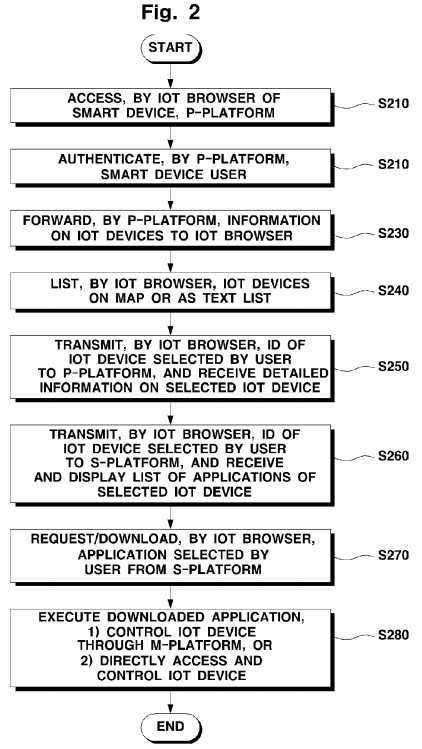
However, the smart device?40?may control the IoT device?115?or receive the IoT mash-up service by accessing an IoT web page for controlling the IoT device?115?and providing the IoT mash-up service, rather than using the downloaded application.
Also, in the above-described exemplary embodiment, the IoT device is selected using the IoT browser. However, the IoT device may be selected in various ways. For example, the IoT device may be searched/selected by directly inputting an ID or a name of the IoT device, or may be selected by searching for a category of the IoT device. Also, the IoT device may be selected by obtaining an ID of the IoT device from a QR code attached to the IoT device, or may be selected by obtaining the ID using short-range communication such as NFC, Zigbee, Bluetooth, etc.
Hereinafter, the above-described IoT browser will be explained in detail. The IoT browser provides a function of allowing the user to search for and select an IoT devices on a map or a list, and a function of displaying a link connected to an application corresponding to the IoT device.
FIG. 3?is a view illustrating a screen of a map-based IoT browser?300?which is displayed on a screen of the smart device40?according to an exemplary embodiment. When the IoT browser is executed in the smart device?40?by the user, the smart device?40?authenticates the user through the P-platform, receives information on the IoT devices, and displays the IoT devices on the IoT browser?300.
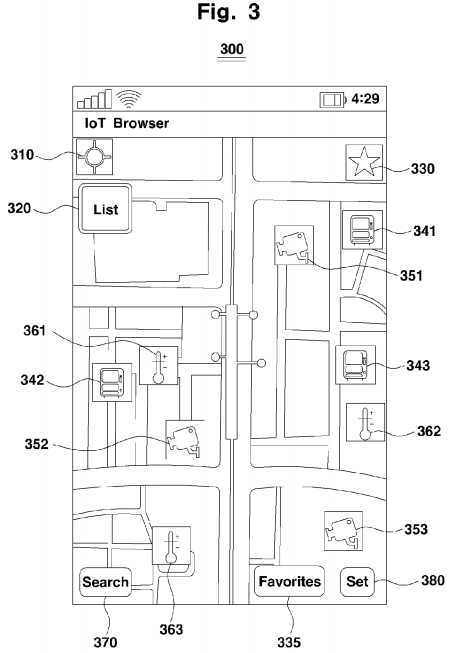
As shown in?FIG. 3, the IoT browser?300, which is executed in the smart device?40?and displayed on the screen, displays icons?341,?342,?343,?351,?352,?353,?361, and?362?corresponding to various IoT devices on the map. The locations of the icons indicate locations of the IoT devices. Specifically, it can be seen from?FIG. 3?that the IoT browser?300?displays icons corresponding to IoT vending machines?341,?342, and?343, IoT surveillance cameras?351,?352, and?353, and IoT thermometers?361?and?362.
Also, the IoT browser?300?may display an icon of an IoT device that is accessible and an icon of an IoT device that is inaccessible in different forms. Specifically, the IoT browser?300?may display the icon of the IoT device that is accessible in color, and may display the icon of the IoT device that is inaccessible in black and white. For example, as shown in?FIG. 3, the IoT browser?300?may display the first IoT thermometer?361?and the second IoT thermometer?362?in black and white to indicate that they are inaccessible, and may display a third IoT thermometer?363?in color to indicate that it is accessible.
The IoT browser?300?displays a current location icon?310, a list view icon?320, a favorite register icon?330, a favorite list icon?335, a search icon, and a setting icon?380. The current location icon?310?is an icon that performs a function of moving to a current location of the user on the map.
The list view icon?320?performs a function of converting the IoT browser?300?from a map-based mode into a list-based mode. When the list view icon?320?is selected, the IoT browser?300?displays the IoT devices currently displayed on the screen in the form of a list.
The favorite register icon?330?is displayed in the shape of a star and performs a function of allowing the user to register a location currently displayed on the map or a currently selected IoT device?115?as a favorite. That is, when the map is displayed and the user selects the favorite register icon?330, the IoT browser?300?registers a center area of the currently displayed map as a favorite.
Also, when information on the IoT device?115?is displayed and the user selects the favorite register icon?330, the IoT browser?300?registers the IoT device?115?as a favorite.
The favorite list icon?335?displays a favorite list which is a list of IoT devices or locations that are set as favorites by the user. Specifically, when the favorite list icon?335?are selected, the IoT browser?300?displays the favorite list in the form of a pop-up window.
The setting icon?380?displays a setting screen for adjusting various setting values of the IoT browser?300. The IoT browser300?may display menus to set a base map, a user ID, a user password, whether to display only an activated IoT device or not, a search term tag, a number of IoT devices that are displayed on a single screen, etc. on the setting screen.
As described above, the IoT browser?300?displays icons of various functions on the screen.
Also, the IoT browser?300?may be displayed in a different layout according to a resolution of the smart device?40. Also, the IoT browser?300?may be configured using the base map set by the user (for example, one of Daum Map, Naver Map, and Google Map).
Also, the IoT browser?300?may select a map area to be initially displayed in various methods. The first method is receiving initial area setting information on a map area to be initially displayed from the P-platform?120?and determining the map area to be initially displayed according to the received initial area setting information. The second method is displaying the area that was displayed last as a map area to be initially displayed. The third method is displaying a current location of the user as a map area to be initially displayed.
As described above, the IoT browser?300?may display a variety of IoT devices based on the map, and, when a specific IoT device is selected, may display a list of applications corresponding to the selected IoT device, and may download and install an application.
Hereinafter, two methods for executing the IoT browser?300?will be explained. When the user selects an IoT browser icon or has a specific code read on an initial screen, the IoT browser?300?may be executed.
FIG. 4?is a view illustrating a first method for executing the IoT browser?300?by the user selecting an icon according to an exemplary embodiment. After the IoT browser?300?is downloaded and installed by the user, an IoT browser icon?410?is displayed on an initial screen?400?of the smart device?40?as shown in?FIG. 4. When the IoT browser icon?410?is selected by the user, the smart device?40?executes the IoT browser?300?and displays it on the screen.
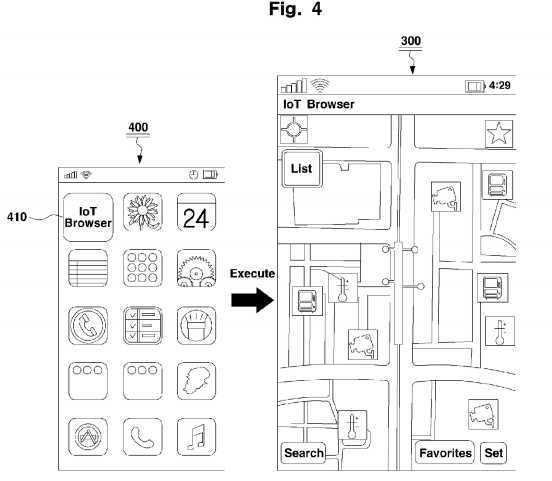
As described, the user may execute the IoT browser?300?by selecting the initial screen icon.
FIG. 5?is a view illustrating a second method for executing the IoT browser?300?using a QR code according to an exemplary embodiment. The QR code is merely an example and the smart device?40?may execute the IoT browser?300?using a specific code which is obtained through various code means (for example, a bar code, a QR code, an RFID, NFC, etc.)
Specifically, the smart device?40?reads a QR code corresponding to the IoT devices?115?first (S510). The QR code corresponding to the IoT device?115?may be attached to the IoT device?115?or may be located nearby. The QR code includes a code value corresponding to information of the IoT device?115?in such a form that the code value can be executed in the IoT browser?300. The code value may include ID information of the IoT device?115.
After that, the smart device?40?analyzes the QR code and extracts the code value. Specifically, the smart device?40?may extract the code value of the QR code in the form corresponding to the information of the IoT device?115?like "iotbrowser://lot?id=xabxsd23x" as shown in?FIG. 5.
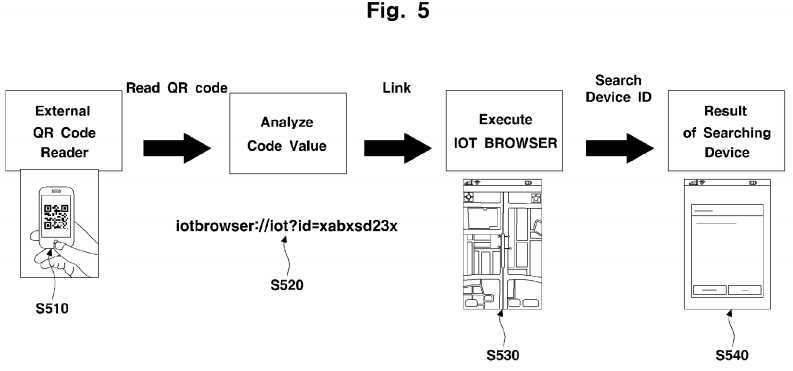
The smart device?40?executes the IoT browser?300?using the extracted code value, and displays the IoT browser?300?on the screen (S530). At this time, the smart device?40?obtains location information of the IoT device?115?from the P-platform120?using the extracted code value, and displays a map area corresponding to the location information of the IoT device115?on the initial screen of the IoT browser?300.
The smart device?40?searches for the IoT device?115?using the ID of the IoT device?115?included in the extracted code value, and displays a result of the searching on the screen (S540).
By reading the QR code using the smart device?40?through the above-described process, the user may directly search for and select the IoT device?115?corresponding to the QR code on the IoT browser?300.
FIG. 6?is a view illustrating a screen of the IoT browser?300?on which a plurality of IoT devices are displayed simultaneously according to an exemplary embodiment. When the IoT devices are superimposed one on another on a specific area, the IoT browser?300?displays plural IoT device icons?610,?620, and?630?on the screen, as shown in?FIG. 6.
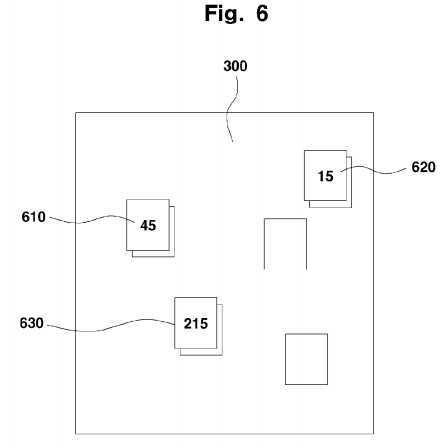
The plural IoT device icons?610,?620, and?630?each are icons representing the plurality of IoT devices. The plural IoT device icons?610,?620, and?630?include numbers therein to indicate a number of IoT devices.
Therefore, the first plural IoT device icon?610?represents?45?Iot devices, the second plural IoT device icon?620?represents15?IoT devices, and the third plural IoT device icon?630?represents?215?IoT devices.
Also, when a specific manipulation (for example, double touch or double click) is input to the plural IoT device icon?610,?620, or?630, the IoT browser?300?increases a zoom level of the map with reference to the plural IoT device icon to which the manipulation is input, and displays the map. When the zoom level reaches the maximum value, the IoT browser?300?may display a list of IoT devices corresponding to the plural IoT device icon on the screen.
The IoT browser?300?may link a virtual device ID or a representative device ID to the plural IoT device icon?610,?620, or630.
As described above, the IoT browser?300?may display the plural IoT device icon representing the plurality of IoT devices.
FIG. 7?is a view illustrating a screen of the IoT browser?300?on which detailed information on a specific IoT device?115?is displayed according to an exemplary embodiment.
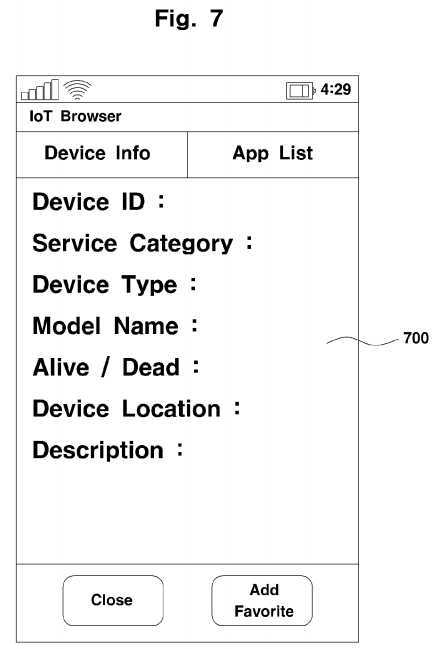
When the user selects an icon of a specific IoT device?115?from among the icons?341,?342,?343,?351,?352,?353,?361, and362?corresponding to the IoT devices displayed on the IoT browser?300?of?FIG. 3, the IoT browser?300?may display a detailed information screen?700?of the IoT device?115?corresponding to the selected icon. The detailed information screen700?may include information like a device ID of the IoT device?115, a service category, a device type, a model name, information on whether the device is alive/dead, device location information, device description, etc.
FIG. 8?is a view illustrating an application list screen?800?corresponding to a specific IoT device?115?according to an exemplary embodiment.
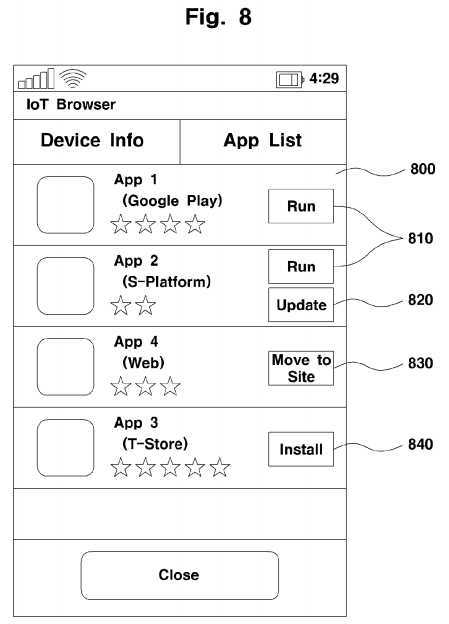
When the user selects an icon of a specific IoT device?115?from among the icons?341,?342,?343,?351,?352,?353,?361, and362?corresponding to the IoT devices displayed on the IoT browser?300?of?FIG. 3, the IoT browser?300?may display the application list screen?800?on the IoT device?115?corresponding to the selected icon as shown in?FIG. 8.
The application list screen?800?is a screen that displays a list of applications through which the user accesses and controls the specific IoT device?115?and uses an IoT service. Specifically, the IoT browser?300?asks the S-platform?140?for an application list corresponding to the IoT device?115?and receives the application list, and displays the application list screen800?using the received application list. For example, it can be seen from?FIG. 8?that there are four applications, App 1, App 2, App 3, and App 4 to access the specific IoT device?115.
The IoT browser?300?displays different buttons on application items according to whether the application is installed or not and whether the application is updated or not. Specifically, when the latest version of the application corresponding to the list is installed in the smart device?400, the IoT browser?300?displays a "run" button?810. When the previous version of the application corresponding to the list is installed in the smart device?40, the IoT browser?300?displays an "update" button?820along with the "run" button?810. Also, when the application corresponding to the list is not installed in the smart device?40, the IoT browser?300?displays an "install" button?840. That is, it can be seen from?FIG. 8?that the latest version of App 1 is installed, the previous version of App 2 is installed, and App 3 is not installed.
When the "run" button?810?is selected by the user, the IoT browser?300?executes the corresponding application. When the "update" button?820?is selected by the user, the IoT browser?300?downloads update data from the S-platform?140?and updates the corresponding application. When the "install" button?840?is selected by the user, the IoT browser?300downloads the corresponding application from the S-platform?140?and installs it in the smart device?40.
Also, the IoT browser?300?may display a "link" button?830?which is linked to a web site on the application list screen?800. For example, in?FIG. 8, "App 4" is an item that indicates a website link providing an IoT service for the specific IoT device115. Accordingly, when the user selects "App 4", the IoT browser?300?displays a corresponding website on the screen.
As described above, the user may easily install and use the application for using the IoT service for the IoT device?115through the application list screen?800.
Hereinafter, a favorite screen of the IoT browser?300?will be explained with reference to?FIGS. 9 and 10. The IoT browser300?may provide a favorite list on specific locations or specific IoT devices.
FIG. 9?is a view illustrating a location favorite list screen?900?according to an exemplary embodiment.
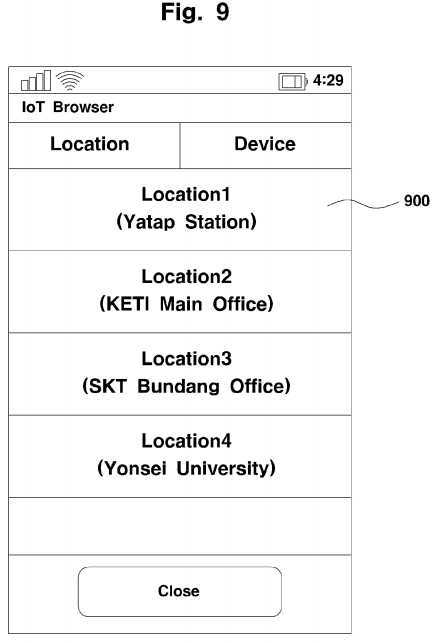
The IoT browser?300?may register specific locations as favorites. Specifically, the favorite register icon?330?may be displayed in the shape of a star as shown in?FIG. 3, and may allow the user to register a location currently displayed on the map or a currently selected IoT device?115?as a favorite. That is, when the map is displayed and the user selects the favorite register icon?330, the IoT browser?130?registers a center area of the currently displayed map as a favorite.
Also, when the favorite list icon?335?shown in?FIG. 3?is selected by the user, the IoT browser?300?displays the location favorite list screen?900?which is a list of locations set by the user as favorites. As shown in?FIG. 9, the location favorite list screen?900?shows that various locations selected by the user are registered. When a specific item is selected on the location favorite list screen?900, the IoT browser?300?displays a map with reference to the location corresponding to the selected item.
FIG. 10?is a view illustrating an IoT device favorite list screen?1000?according to an exemplary embodiment.
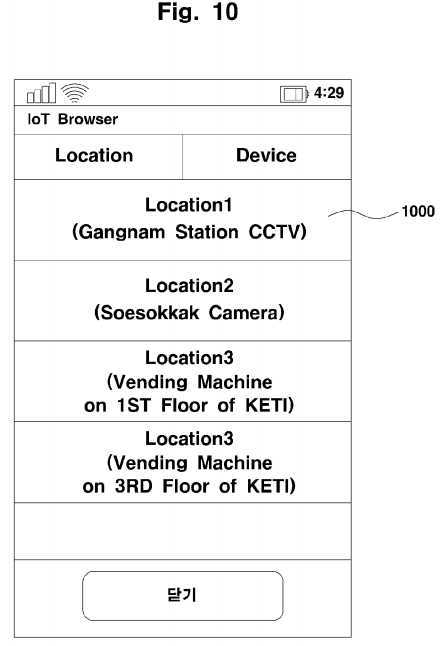
The IoT browser?300?may register specific IoT devices as favorites. Specifically, the favorite register icon?330?may be displayed in the shape of a star and may allow the user to register a location currently displayed on the map or a currently selected IoT device?115?as a favorite. When detailed information of the IoT device is displayed as shown in?FIG. 7?and the favorite register icon is selected, the IoT browser?130?may register the currently displayed IoT device as a favorite.
Also, when the favorite list icon?335?shown in?FIG. 3?is selected by the user, the IoT browser?300?displays the IoT device favorite list screen?1000?which is a list of IoT devices set by the user as favorites.
As shown in?FIG. 10, the IoT device favorite list screen?1000?shows that various IoT devices selected by the user are registered. When a specific item is selected on the IoT device favorite list screen?1000, the IoT browser?300?displays a map with reference to the location of the IoT device corresponding to the selected item.
As described above, the IoT browser?300?provides the favorite find function on locations or IoT devices.
FIG. 11?is a view illustrating a base map setting screen?1100?according to an exemplary embodiment.
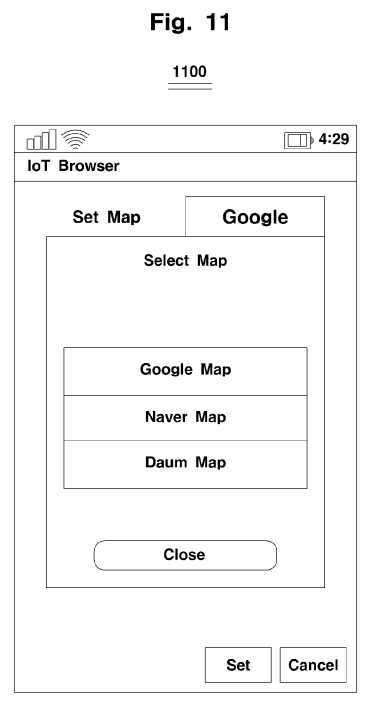
When the setting icon?380?shown in?FIG. 3?is selected by the user, the IoT browser?300?may display the base map setting screen?1100?as shown in?FIG. 11. The base map setting screen?1100?may be a screen through which the user selects a base map to display locations of the IoT devices on the IoT browser?300, and may display a list of various maps as shown in?FIG. 11. When a specific map is selected by the user, the IoT browser?300?uses the map selected by the user as a base map and displays the locations of the IoT devices.
The IoT software platform?100, the D-platform?110, the P-platform?120, the M-platform?130, and the S-platform?140according to an exemplary embodiment are not limited by their respective names and may be applied to any software, electronic apparatus or system that corresponds to the corresponding functions.
Also, the IoT software platform?100, the D-platform?110, the P-platform?120, the M-platform?130, and the S-platform?140may have various forms other than the software platform, such as library, software solution, software package, software framework, individual software, etc.
The technical idea of the exemplary embodiments may be applied to a computer readable recording medium on which a computer program to perform the above-described functions of the IoT browser?300?is recorded. Also, the technical idea of the exemplary embodiments may be implemented in the form of a computer readable code which is recorded on a computer readable recording medium. The computer readable recording medium may include all kinds of data storage apparatuses that can be read by a computer and can store data. For example, the computer readable recording medium may be a read only memory (ROM), a random access memory (RAM), a CD-ROM, a magnetic tape, a floppy disk, an optical disk, a hard disk drive, etc. The computer readable code or program which is stored in the computer readable recording medium may be transmitted through a network which is connected among computers.
The smart device?40?according to an exemplary embodiment may be substituted with any mobile device that can execute the IoT browser to provide the IoT service, besides a smartphone and a tablet PC.
SRC=https://www.google.com/patents/US20140108943
Method for browsing internet of things and apparatus using the same,布布扣,bubuko.com
Method for browsing internet of things and apparatus using the same
标签:des style blog http color os strong io
原文地址:http://www.cnblogs.com/coryxie/p/3866691.html